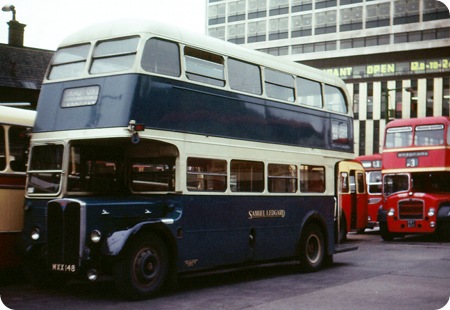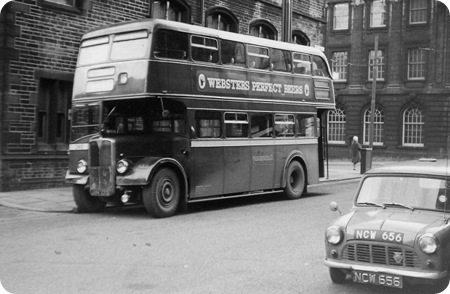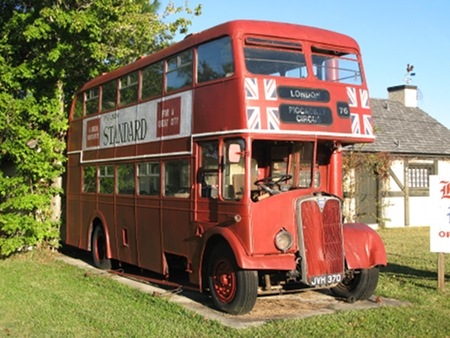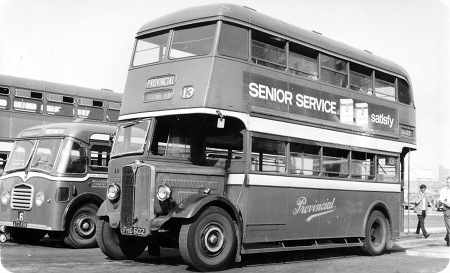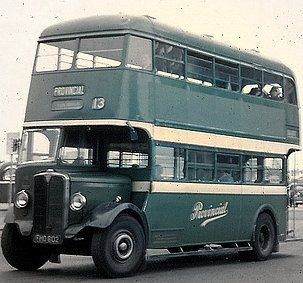Samuel Ledgard – AEC Regent III RT – MXX 148
Samuel Ledgard
1949
AEC Regent III RT
Weymann H30/26R
In 1937-8 London Transport got together with AEC to jointly design and produce a new double deck chassis with AECs large 9.6 litre oil engine with air operated gearbox and brakes. From what I can gleam the prototype entered service in 1938 as ST1140 (EYK 396) but it had a body taken from a scrapped Leland Titan TD 111 or 118 seems to be a bit of a dispute on that. But in July 1939 it was given a brand new body and was then renumbered RT1. London Transport then ordered 150 more, RT2-151 which were delivered by the time production ceased in 1940 because of the war those 150 were bodied by London Transport themselves.
I have another dispute here and that is by the end of production in 1954 according to one source nearly 7000 RTs had been delivered to London Transport but another source says that the highest fleet number was 4825 that’s a difference of 2000 or so. Maybe the 7000 is for total build but I do not think there was that many delivered new to other operators do you know leave a comment.
There were 4825 RT’s but the RT Family included RTL’s and RTW’s so the figure of nearly 7000 is probably correct.
Anonymous
The RTL was a Leyland Titan PD2/1 chassis with Leyland O.600 engine but with AEC preselect gearbox and bodied by Park Royal 1149, Metro-Cammell 450 and Weymann 31 all to a London Transport design.
The RTW was as the RTL except they were PD2/3 and all bodied with 8 foot wide bodies instead of the normal 7’ 6” and all 500 were bodied by Leyland.
There was also the SRT which were 1939 AEC Regent STLs rebodied with brand new RT bodies there was 160 built in total.
So that makes 4825 RTs 1630 RTLs 500 RTWs which makes 6955 so there is the approx 7000 and if you add in the 160 SRTs this will give a total of 7115.
Spencer
New 7/12/1952
A.E.C. Regent III RT 0961 Chassis No: 6758
Engine Type: AEC 6cyl. A204 9.6ltr
Weymann H30/26R
Body No: W269
Entered Ledgards service 5th November 1963
Withdrawn: 14/10/67
Sold To Dunn (A1 Service) 02/68
Withdrawn: 11/71
Terry Malloy
What a nostalgic shot-a Sammie RT alongside some of West Yorkshire’s finery, and set in Chester Street bus station. There always seemed to be an RT parked up either there or in Otley bus station, as they were so numerous in the fleet. They had a lovely reassuring tickover, plus a delightfully tuneful transmission (fluid flywheel/pre-selector gearbox) and seemed to have an aura of indestructibility about them. Shame West Yorkshire didn’t keep a few running after takeover. It would have been interesting to see some in red and cream, almost harking back to their London days….
Brendan Smith
Brendan it is not generally known that, in the very hurried arrangements for the WYRCC takeover of Samuel Ledgard, West Yorkshire fleet numbers were allocated for most if not all of the Samuel Ledgard vehicles. The entire RT class, at least one of which (MLL 920) received a new C of F in the final week, were to be DA 1 – 34. I was lucky enough to be the first driver of the very first Otley Depot RT – NXP 864, RT 4611. It was overhauled and ready for use in the garage one Saturday night and I just couldn’t contain my excitement so pestered the late garage man to let us use it for the last two trips of our late turn. 8.10pm Otley – Leeds, 8.55pm Leeds – Otley, 9.50pm Otley – Leeds, 10.35pm Leeds – Otley.
As expected it swallowed up the long ascent of the A660 to Bramhope in very fine style and comfort.
Chris Youhill
12/01/17 – 11:21
I think one or two comments on Spencer’s post (above) are appropriate.
The chassis of the RTLs and RTWs differed from PD2/1s and PD2/3s in having a longer wheelbase (16’4" instead of 16’3") and air brakes (instead of vacuum) – there may have been other differences. I don’t think Leyland ever called the RTL/RTW chassis PD2/1 or PD2/3.
There were 32 RTLs supplied new with Weymann bodies (RTL1307, 1601-31), making the RTL total 1,631 and the RT/RTL/RTW total 6,956.
The SRTs came about by virtue of there being more new bodies available than chassis, so 160 ‘RT’ bodies were placed on existing STL chassis to make the SRT class. When the supply of chassis caught up the SRT bodies were transferred to new RT chassis, but those are included in the RT total of 4,825 – so to get the total of ‘RT’ family buses up to 7,115/6 you’re counting the SRT bodies twice.
David Call
13/01/17 – 06:41
The picture shows MXX 148 on Ledgard’s longest stage carriage route, one taken over with B & B Tours in the mid 1930s. The destination shown is "Bradford via Otley and Manningham Lane" and the display for the return journey is just visible "Harrogate via Manningham Lane and Otley." I was always surprised that Menston Village was not mentioned, this being the chief "attraction" of the service compared with the WYRCC direct 53.
Chris Youhill
13/01/17 – 06:42
David Call is right about the why of the SRT but although the frame modifications were extensive, amounting to a complete re-profiling of the side members of the chassis,what was not upgraded was the engine (7.7) gearbox (spring-operated) and brakes (vacuum).
Stephen Allcroft
13/01/17 – 06:42
I agree with David in his view that the RTL and RTW classes were not classified as members of the PD2 breed. Ken Glazier, whose knowledge on London Transport matters I have always found to be impeccable, gives the RTL as type 7RT and the RTW as type 6RT. The SRT was purely a stop gap to present a modern looking fleet in the early ‘fifties when chassis deliveries lagged behind bodywork supplies. In typical LT fashion, the STL type chassis under the RT type body was ‘modernised’ at ridiculous expense, and the whole project foundered when it became apparent that the brakes were decidedly incapable of stopping the bus effectively. By that time, chassis supplies were outpacing body deliveries, which is why LT turned to Cravens and Saro, so the whole SRT programme was a fiasco in every way. As for the 7000 total figure for RT/RTL/RTW classes, OK, but there were never that many in service at the same time.
Roger Cox
13/01/17 – 10:09
……and they had to move the fuel tank to the other side of the vehicles too, Stephen! The other tragedy was that the STL’s selected for conversion to SRT’s were the 1939 15STL16’s, the most modern STL’s in the fleet and pretty-well up to RT standards in many respects, having automatic chassis lubrication, amongst others. And why not, for London Transport had hoped that this batch of STL’s would be RT’s which, in the end, turned out to be wishful thinking.
Chris Hebbron
Quick links to the - Comments Page - Contact Page - Home Page
